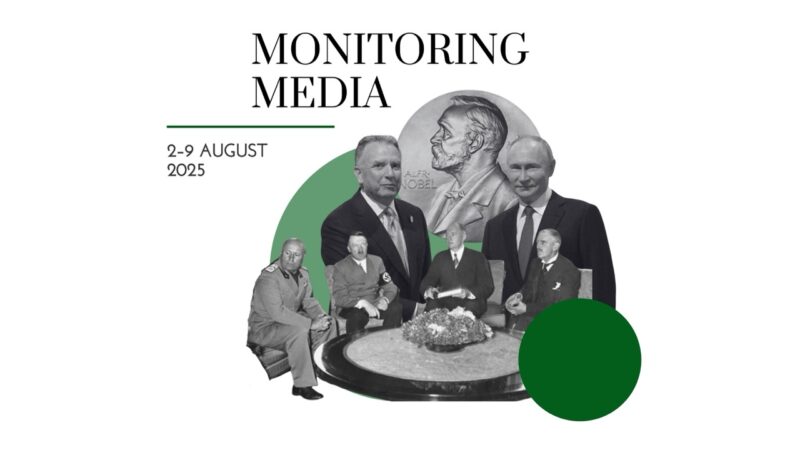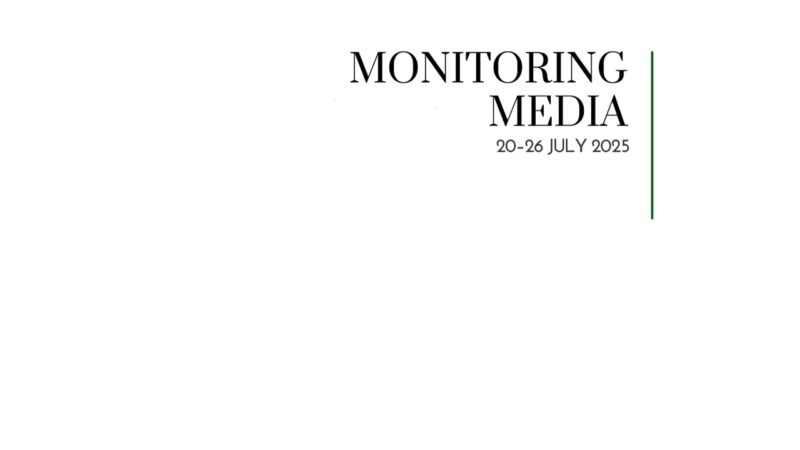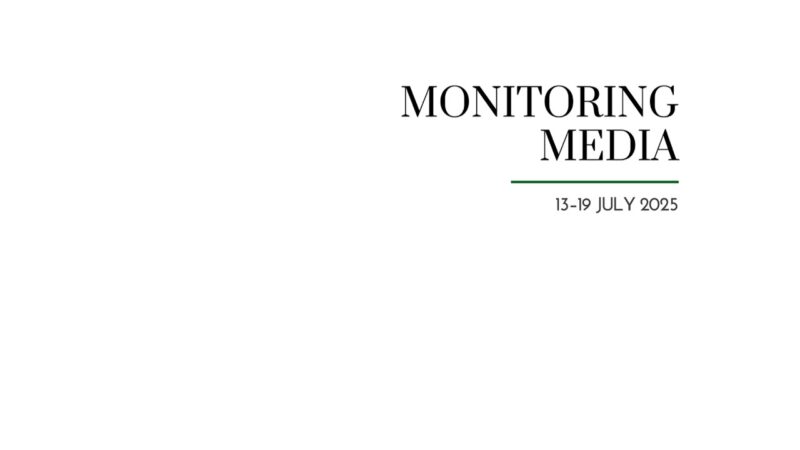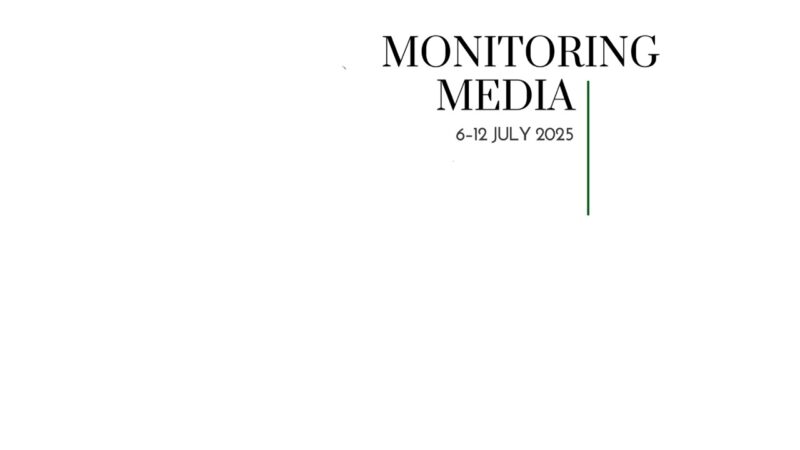Incalculable damage from Russia’s destruction of the Kakhovka Dam

CIUS weekly report on North American media coverage of Ukrainian affairs, 3–9 June 2023
Three publications (The Conversation, Foreign Affairs, and The National Interest) were selected to prepare this report on how the situation in Ukraine has been portrayed in the North American press during the past week (3–9 June 2023). The sample was compiled based on their impact on public opinion as well as on their professional reputation, popularity among the readership, and topical relevance. These three publications represent centrist and conservative viewpoints on the political spectrum.
This report covers only the most-read and relevant articles about Ukraine, as ranked by the respective North American publications themselves in the past week. Its scope covers promoted articles on home pages and articles from special sections on Ukraine, with the hashtag #Ukraine, from the paper editions of the publications, and about Ukraine from opinion columns and editorials.
Topics featured in the selected articles:
- Ukraine’s current affairs: destruction of the Kakhovka Dam is a catastrophe for civilians but not an obstacle for Ukraine’s counteroffensive; lustration may be a useful tool to address collaboration on occupied territories; paramilitary units fighting on both sides add many “grey areas” to the definition of Ukraine and Russia belligerents;
- The world and Ukraine: EU countries should take the heaviest burden of supporting Ukraine; the West should design a unique security framework for Ukraine before it joins NATO.
Main arguments:
The destruction of the Kakhovka Dam is a multi-tiered catastrophe for Ukraine. Matt Williams (The Conversation) presents an overview of articles that analyze the consequences of the Kakhovka Dam breach for Ukraine’s infrastructure, war plans, and security. The dam was a massive engineering object that supplied drinking water to thousands of people, nourished crop fields, and was used for cooling water for reactors at the Zaporizhia Nuclear Power Plant. With its destruction on 6 June 2023, the reactors of the biggest nuclear facility in Europe risk becoming overheated and exploding due to a potential disruption of water supply. That being said, according to the International Atomic Energy Agency, there is no immediate risk of a nuclear catastrophe: “Five of the six reactors there have already been put in cold shutdown, which requires relatively little water. The sixth reactor is cooled with water from a nearby pond. The danger would be if the pond became depleted.” Apart from that, the destruction of the dam neatly fits the Kremlin’s “coercive strategy” that justifies the destruction of civilian infrastructure in order to achieve greater military goals: “For more than 20 years, Russian military journals have emphasized the need to conduct noncontact warfare and target critical infrastructure.” In this light, the Kakhovka Dam might be only one of many such objects targeted by Russians; recall that in mid-September 2022 the invaders tried to destroy a dam on the outskirts of Kryvyi Rih. Finally, Williams argues that the destruction of the Kakhovka Dam will interrupt Ukraine’s counteroffensive. Vast areas on both banks of the Dnipro and to the north of Crimea will become flooded for weeks, if not months. This will make the advancement of Ukrainian ground forces more challenging. Williams concludes that “Russia is less interested in liberating Ukraine from its present leadership [a stated reason for its invasion] than it is in destroying its ability to function as a sovereign nation.”
In his interview with The Conversation, Najmedin Meshkati, a professor and nuclear safety expert, explains what the destruction of Kakhovka Dam means for the safety of the Zaporizhia Nuclear Power Plant. Primarily, in order to operate safely, whether functioning or closed down, the nuclear power plant needs two lifelines: water and electricity. The former is needed “to reduce the residual heat from the shutdown reactors, to cool the spent fuel, and to cool the emergency diesel generators.” The latter is needed to power the cooling pumps. As of today, despite the dam’s destruction, neither lifeline is in immediate jeopardy. However, the situation may change at any moment due to the nature of the war. Secondly, the majority of the station’s reactors are operating in cold shutdown mode: “Cold shutdown is the state in which you do not need to constantly run the primary cooling pumps at the same level to circulate the cooling water in the primary cooling loop.” Therefore, there is a significantly decreased probability of unpredictable security incidents, in particular those triggered by the human factor or disruptions in water and electricity supply. Thirdly, besides cooling reactors, the station needs a reliable source of electricity to cool the six huge pools and dozens of outdoor casks with spent fuel. This fuel is radioactive and very hazardous to the environment. If the situation spirals out of control, if cracks emerge on the overheated casks, “this would be similar to the detonation of a ‘dirty bomb,’ which, depending on wind direction and dispersion radius, could result in radioactive contamination.” Meshkati concludes with regret that following the destruction of the Kakhovka Dam, there still has been no draft resolution from the UN Security Council on securing the Zaporizhia Nuclear Power Station under conditions of war.
Christopher Morris (The Conversation) also discusses the outcomes of the Kakhovka Dam destruction, focusing on the new complications for Ukraine’s counteroffensive and provision of relief to civilians. Speaking of the former, any crossing of Dnipro downstream by ground forces will become more complicated in the foreseeable future. Not to mention that heavy machinery may get stuck or even drown in the newly formed swamps. As for providing relief to civilians, Morris highlights that Ukraine’s attempts to evacuate them from affected areas “will deplete manpower and resources when the conflict is at a critical juncture.” At the same time, Morris argues that “the relatively modest military benefit [Russia will gain from the destruction of the dam] in no way justifies the massive and far-reaching destruction unleashed by the floodwaters.” The events of the previous months demonstrate that Ukrainian forces have always been good at adapting to changes on the battlefield, “and this will serve them well in the next phases [of the war].” In sum, Morris believes that the destruction of the Kakhovka Dam has not become a major setback for Ukrainian forces that would put their counteroffensive on hold. Finally, Morris compares the detonation of the Kakhovka Dam to the destruction of the Irpin Dam in the first days of the invasion. The latter was carried out by Ukrainian defenders in order to stop Russia’s advancement toward Kyiv, and served its goal well. The former, contrarily, does not give Russians any significant military advantages but causes the obliteration of Ukraine’s civilian infrastructure on an unprecedented scale.
Ukraine may use lustration to investigate collaboration in occupied territories but should avoid legal pitfalls. Geoff Dancy, Kathryn Sikkink, Mykhailo Soldatenko, and Patrick Vinck (Foreign Affairs) address the legal complexities surrounding the investigation of collaboration of Ukrainians with Russian occupiers: “If Kyiv successfully regains significant territory, as it did in the fall of 2022, it will have to decide what to do with people in those areas who worked with or otherwise assisted Russian occupation authorities and forces in their repression of local populations and propaganda.” On the one hand, long before the invasion Russia created a network of collaborators who helped it obtain information about military targets, crush dissent in occupied territories, spread propaganda, and sabotage Ukrainian democracy from within. On the other hand, some people with a social conscience nevertheless also agreed to collaborate in exchange for providing relief to their communities under occupation.
The predominant public opinion in Ukraine supports strong and sometimes unequivocal retribution against anyone who aided the enemy. The authors argue that carefully crafted lustration may provide a solution. Lustration is “a transitional justice mechanism aimed at identifying individuals who pose a significant danger to democracy and often barring them from public positions.” At the same time, “people who had no other choice but to coexist or even cooperate with the aggressor” would have all such charges rescinded. The authors outline a few problems obstructing a fair lustration process in Ukraine. Above all, the Ukrainian criminal justice system may lack the capacity to address all cases; in Crimea alone more than 200,000 people may have committed collaboration crimes. Secondly, it may be very hard to create a clear-cut definition of a harmful collaboration; a chaotic “witch hunt” would damage Ukraine’s democracy for years. Thirdly, lustration mechanisms should not contradict the basic principles of human rights, national law, or national interest; they should “give a reasonable justification for any targeting criteria used” and be implemented transparently and on time. Fourthly, lustration should not be used as a means for governing elites to prosecute their political competition.
Paramilitary units add complexity and subtract clarity from characterization of the sides in the Russo-Ukrainian war. James Horncastle (The Conversation) assesses the role of paramilitary units in the Russo-Ukrainian war, such as the Wagner Group, Azov Brigade, Freedom of Russia Legion, and Russian Volunteer Corps. They are irregular elements on the conventional battlefield where the two national armies collide. Horncastle warns that “while these units give both parties tactical advantages they otherwise would not possess, the loose nature of their control also means they can undermine their respective war efforts.” Speaking of the benefits to the governments employing them, the paramilitary units demonstrate high combat prowess and “can perform actions in which states do not want to be held complicit.” However, these benefits come with many drawbacks. Primarily, the paramilitary units are wont to pursue their own agendas and may operate outside of the standard army chain of command. Secondly, they may employ tactics of a dubious moral nature, such as human-wave attacks on fortified positions (resorted to by the Wagner Group). Thirdly, they often follow radical or far-right ideologies. Horncastle analyzes the case of the incursion of anti-Putin Russian paramilitary units into Belgorod oblast and stresses that it lit many red lights for the West. The Freedom of Russia Legion and the Russian Volunteer Corps include many radical nationalists (which plays to Russia’s narrative that Ukraine harbours neo-Nazis); they are not following the orders of Ukraine’s command, and instead of attacking military infrastructure in Russia’s interior, they aim to establish control over geographical territories; they are believed to use Western weapons on the Russian soil, which discourages many governments allied with Ukraine from sending more arms. Horncastle concludes that “although Ukraine denies responsibility for the Belgorod attacks, and at this stage there is no reason to doubt this claim, the country’s employment of paramilitaries and other groups make it difficult to prove otherwise as well.”
European countries need to be more active and consistent in supporting Ukraine’s war effort. Gil Barndollar and Luke Cocchi (The National Interest) argue that it is Europe, not the US, who should take the major burden of supporting Ukraine in its defensive war against Russia: “The majority of military aid—$47 billion of a total of $69 billion to date—comes from the United States. This situation is neither desirable nor sustainable for America, Europe, or Ukraine.” Barndollar and Cocchi highlight that the US’s support is at risk of shrinking in the future. During the last twelve months, the willingness of US citizens to provide military assistance to Ukraine dropped from 73 percent to 58 percent. “With the stubborn persistence of inflation, the growing challenge of China, and a federal debt showdown in progress, American wariness about a major, long-term aid commitment to Ukraine is warranted.” On top of that, should a new presidential administration come to the White House in 2024, the national foreign policy priorities will likely change. Barndollar and Cocchi continue that the Russo-Ukrainian war is a pan-European affair, as it is being fought close to the borders of the EU and far from the US and other sovereign countries. At the same time, the military-industrial complex of the EU is not prepared to satisfy Ukraine’s demand for ammunition and weaponry. That complex has only recently started to get more funding, revitalize, and standardize; Europe today “operates up to five times as many different versions of key weapons systems, like tanks and artillery pieces, as the United States.” Barndollar and Cocchi conclude that “in the long term, Europe needs a more robust defense industrial base and far larger munitions stockpiles. But for the immediate future, “buying American” can equip Ukrainian troops, attrit the Russian Armed Forces, and ensure Europe has the breathing room to rearm […] But greater European commitment would ensure that Western military aid to Ukraine is politically, financially, and logistically sustainable.”
The West should introduce a temporary framework to help Ukraine defend and develop itself militarily. Eric Ciaramella (Foreign Affairs) argues that Ukraine needs a binding commitment from its Western allies to guarantee its security before joining NATO officially. This commitment can be modelled in part after the US’s defence relationship with Israel and will help to sustain a well-trained and well-equipped Ukrainian military. The first signs of such a commitment-in-the-making are already visible: the Pentagon intensified its cooperation with Ukraine, the issues of the F-16 aircraft supply became crucial to the agenda, and the weaponry deliveries only increased in size. The West should also send a message to Putin that time is not on his side and that Ukraine will never return to the Russian sphere of influence. The objective behind the Israeli defensive model is possessing the “ability to deter and, if necessary, defeat a larger adversary by possessing superior technologies and tactics.” However, unlike Israel, Ukraine is a bigger country that needs to counter a formidable and well-organized army equipped with nuclear weapons. This difference should always be kept in mind. Ciaramella opines that “the West should adopt a new term, such as qualitative deterrent balance, that fits Ukraine’s unique case. In doing so, it should commit to ensuring that Kyiv has a mixture of superior equipment, training, and technology geared toward matching or offsetting Russia’s numerical battlefield advantages in the long term.” The defence commitment to Ukraine will also take time to develop and will significantly depend on the intensity of the war. Apart from that, Ciaramella highlights that the “future security arrangement for Ukraine must be built on solid legal and political foundations” to avoid repetition of the Budapest Memorandum scenario. The obligations of all parties should be clearly defined and honoured. They should not depend on the rotation of political elites in the Western states. Finally, Ciaramella argues that Ukraine should be helped with increasing its domestic production capacity of weaponry and ammunition. In the Soviet times, Ukraine’s military-industrial complex was very well-developed; today, it should be restored and integrated into the European supply chains.





